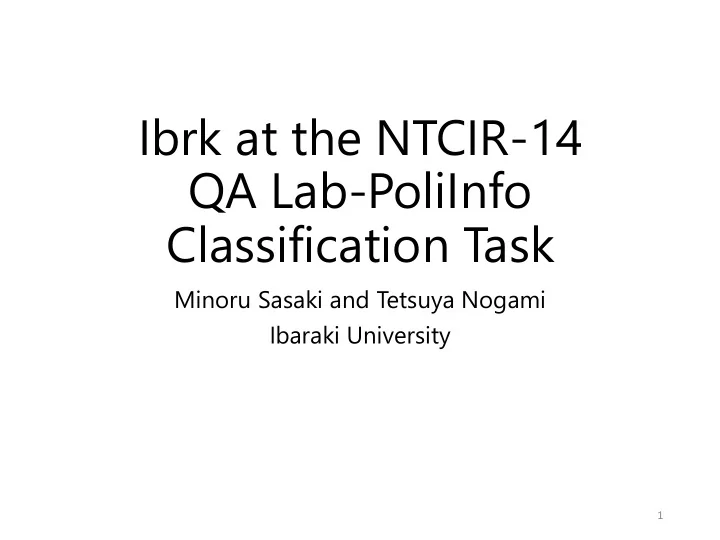

Ibrk at the NTCIR-14 QA Lab-PoliInfo Classification Task Minoru Sasaki and Tetsuya Nogami Ibaraki University 1
Introduction • Stance Classification • automatically identify speaker's position on a specific target of topic from text. • The speaker's position is one of Three labels. • Support ( favour/favor, agree, pro) • Against (oppose, disagree, con) • Neutral ( none, unrelated, neither) • For example, • we want to know whether the former president Barack Obama is in favor of stricter gun laws from his speeches. 2
Introduction • Previous researches have demonstrated many approaches to solve stance classification tasks. • (Rajadesingan 2014) • Use semi-supervised learning in online forum. • (Bamman 2015) • Use unsupervised method • (Ebrahimi 2016) • Use a supervised probabilistic classification in tweets. 3
Stance Classification Using Machine Learning • In supervised approach, • this task is difficult due to imbalanced class sizes. • Stance classification task usually requires a large amount of training data to obtain many sentiment expressions. • We propose to use sentiment dictionary for stance classification. • a sentiment dictionary is introduced to label each word with polarity information in the dictionary. 4
Purpose of This Study • We propose a stance classification system using sentiment dictionary. • To evaluate the effectiveness of our system, • we conduct some experiments to compare with the result of the baseline method using Support Vector Machine (SVM). 5
System Description Input Sentiment Sentence Dictionary Count Output Words Matching positive and Stance negative labels Relevance Output Classifier Relevance Fact-Checkability Output Classifier Fact-Checkability 6
Stance Classifier (1/2) • If each extracted word exists in the sentiment dictionary, • the polarity of the word is extracted to identify sentiment polarity label (positive or negative). • The system counts up the number of positive and negative labels in the sentence. Input Sentiment Sentence Dictionary Count Output Words Matching positive and Stance negative labels 7
Stance Classifier (2/2) • If the number of positive labels is greater than the number of negative labels, • the system assigns “support” label to the sentence, otherwise the system assigns “against” label. Input Sentiment Sentence Dictionary Count Output Words Matching positive and Stance negative labels 8
Relevance Classifier and Fact-checkability Classifier • We extract nouns, verbs and adjectives from the input sentence in the training data. • Each set is represented as a feature vector by calculating frequencies of the features. • We construct two classifiers by Support Vector Machine (SVM) from labeled feature vectors. • The both classifiers are used to predict labels. Output Relevance Relevance Classifier Input Words Sentence Fact-Checkability Output Classifier Fact-Checkability 9
Experiments • NTCIR14 QA Lab-PoliInfo Classification Task Dataset • 14 Topics • about 30,000 sentences in training data • 3,412 sentences in test data • Sentiment Dictionary • Japanese Sentiment Polarity Dictionary • created by Tohoku University • We use this dictionary to obtain a sentiment polarity of word. 10
Experimental Results (1/6) • Precision for the topic “Integrated Resort” Methods Support Against Neutral Our System 7.19% 15.63% 92.10% Baseline System 0% 0% 90.73% • Precision, recall and F-measure for this topic Methods Precision Recall F-measure Our System 77.80% 77.80% 77.80% Baseline System 90.70% 90.70% 90.73% 11
Experimental Results (2/6) • Precision for the topic “Integrated Resort” Methods Support Against Neutral Our System 7.19% 15.63% 92.10% Baseline System 0% 0% 90.73% • The proposed system obtained higher precision than the baseline system using SVM. • These results show that the sentiment dictionary is effective for stance classification. • When we use the baseline system, all samples are classified into “neutral”. 12
Experimental Results (3/6) • Precision, recall and F-measure of test data for this topic • All scores are decreased about 13% in comparison to the baseline system. • Because there are a lot of neutral samples in the training and test data. Methods Precision Recall F-measure Our System 77.80% 77.80% 77.80% Baseline System 90.70% 90.70% 90.73% 13
Experimental Results (4/6) • Results for the “relevance” of the topic label Relevance Not Relevance Method Precision Recall Precision Recall Our System 86.50% 100% NaN 0% • All data were classified as relevant to the topic. • It is difficult to detect sentences that are not related to the topic by using SVM. 14
Experimental Results (5/6) • Results for the “fact -checkability ” classification label fact-checkable not fact-checkable Method Precision Recall Precision Recall Our System NaN 0% 64.6% 100% • All data were classified as “not fact - checkable”. • It is difficult to detect sentences that we can conduct a fact-check by using SVM. 15
Experimental Results (6/6) • Results for the class label using our system label Precision Recall F-measure 6.3% 17.8% 9.3% fact-check-support 4.5% 20.2% 7.4% fact-check-against class-other 93.4% 77.0% 84.4% • The small number of test data can be classified correctly. • In the future, we will improve our system to classify “class - other” samples effectively. 16
Conclusions • We proposed a new method for stance classification using sentiment dictionary. • The effectiveness of the proposed method was evaluated on the NTCIR-14 QA Lab-PoliInfo classification task formal run dataset. • The experimental results show that the proposed methods obtains higher precision than the baseline method using SVM. • However, the precision of our system is decreased about 13% in comparison to the baseline system for the “neutral” samples. 17
Recommend
More recommend